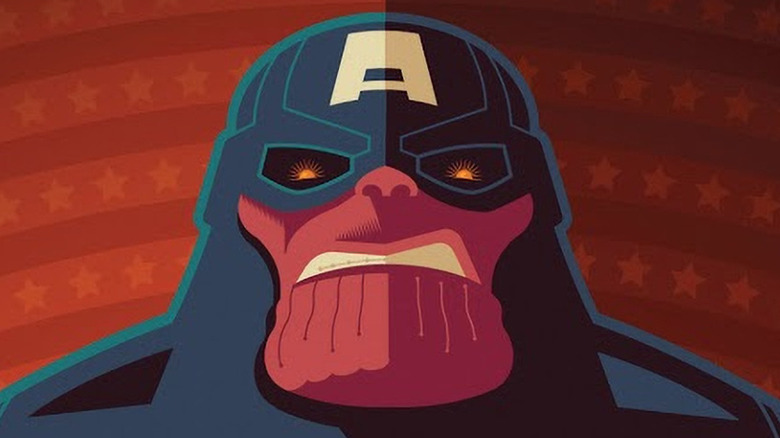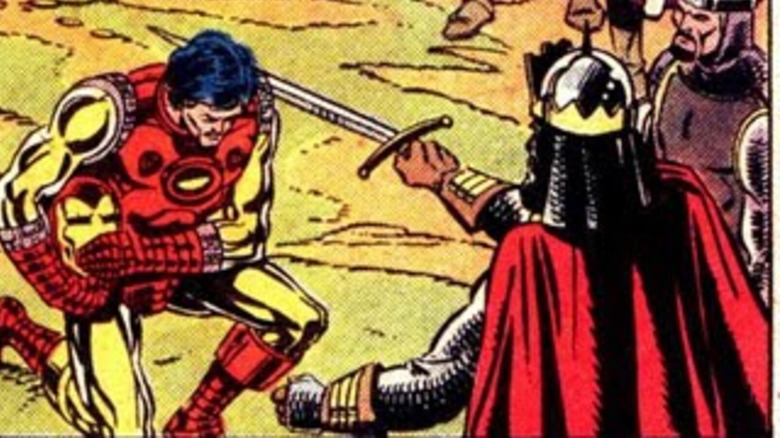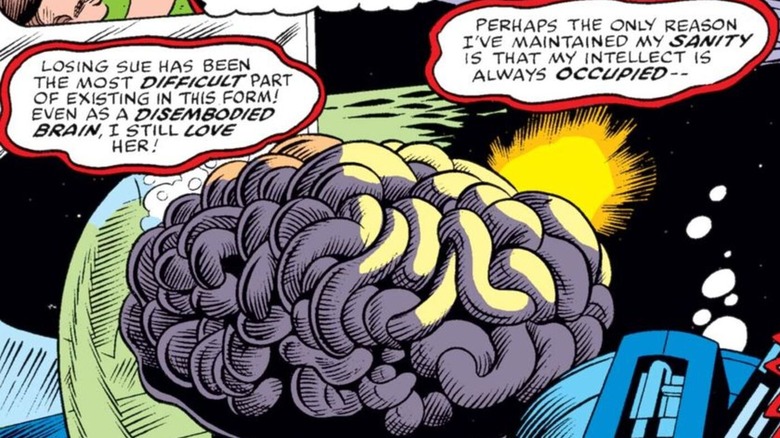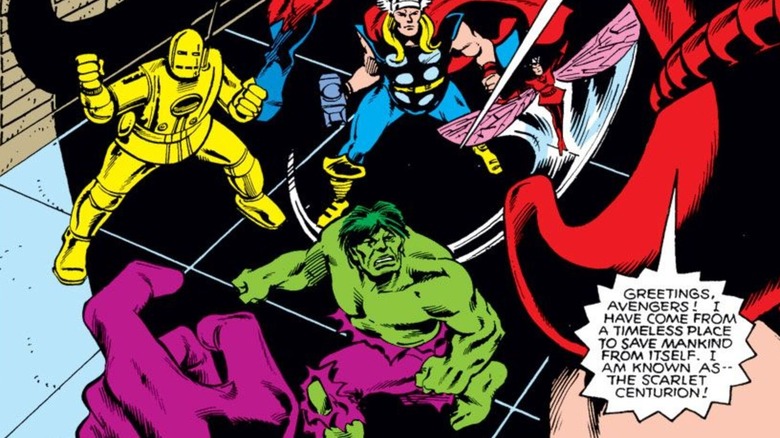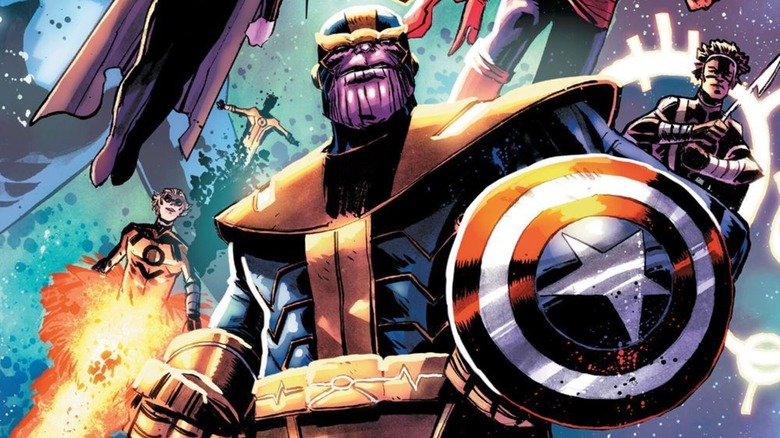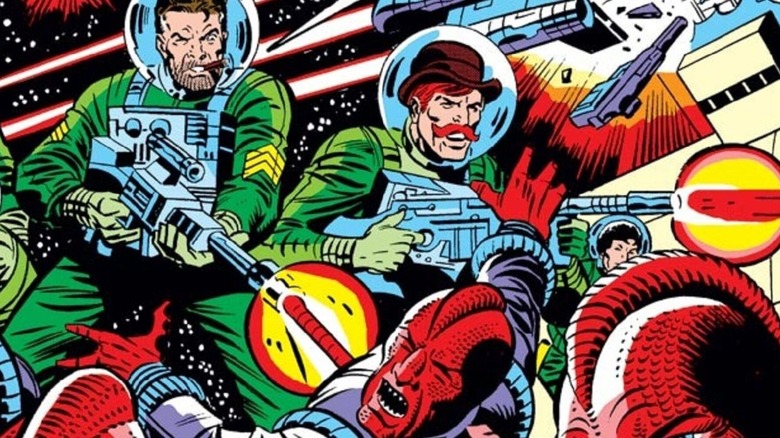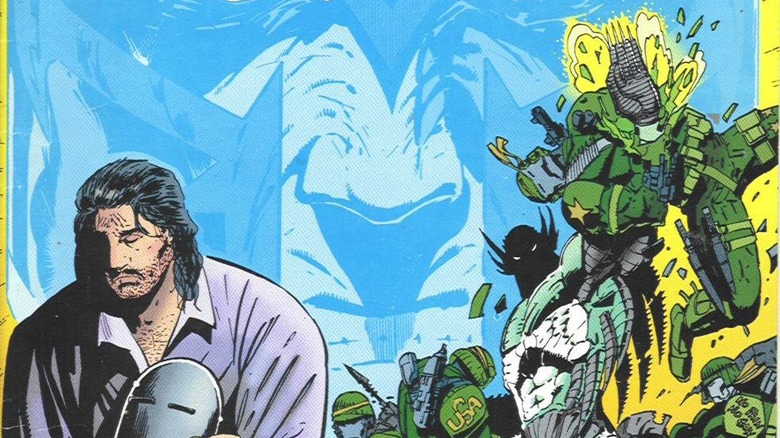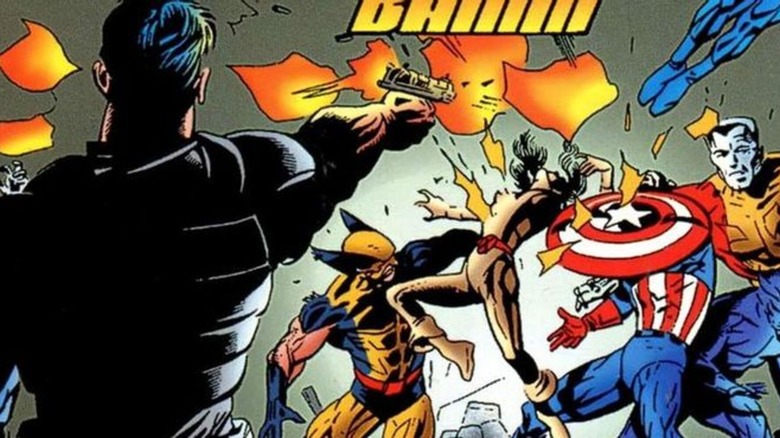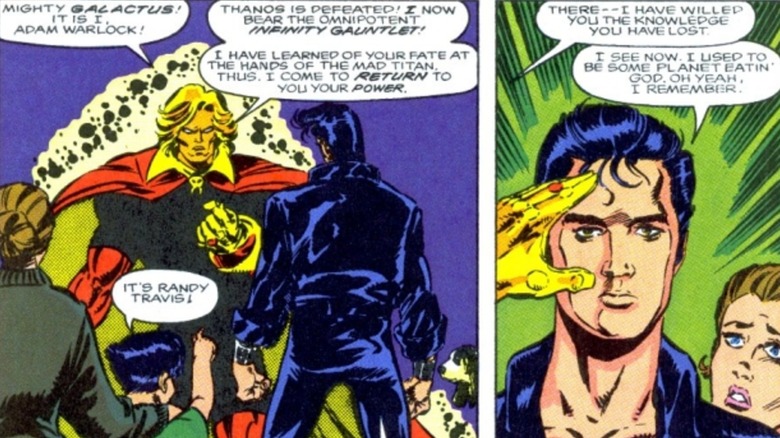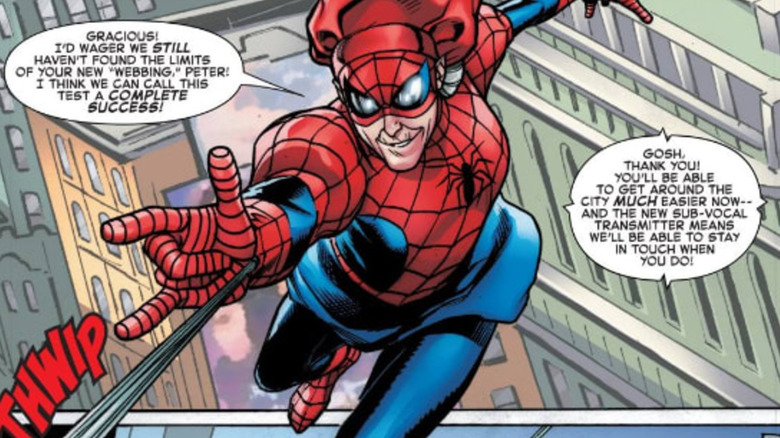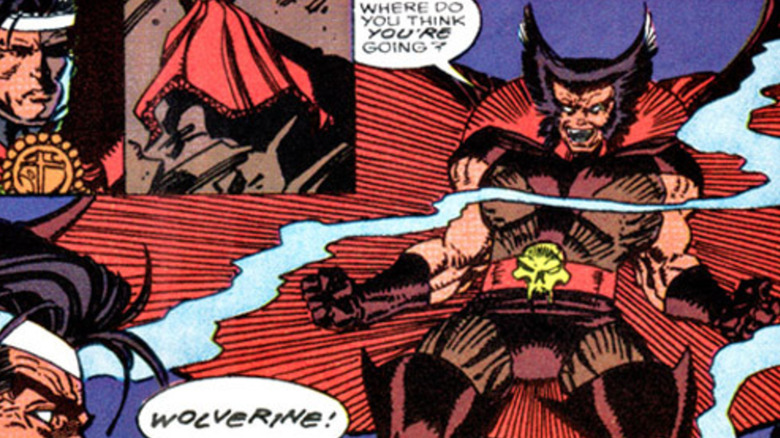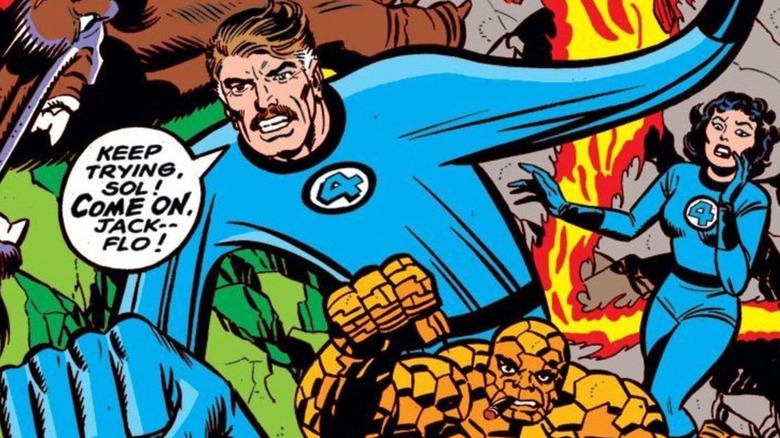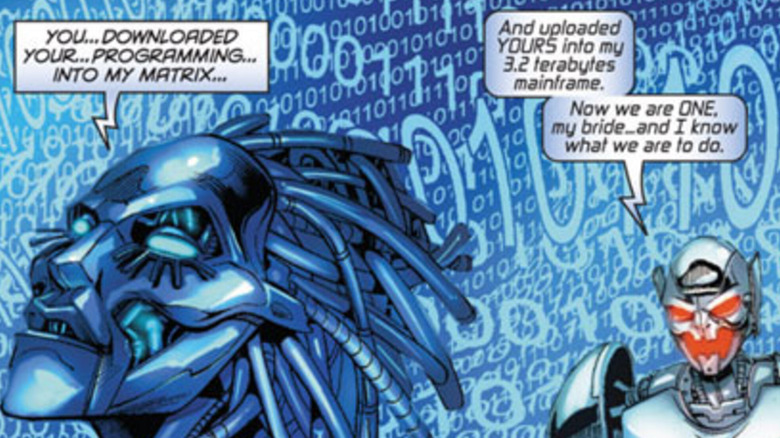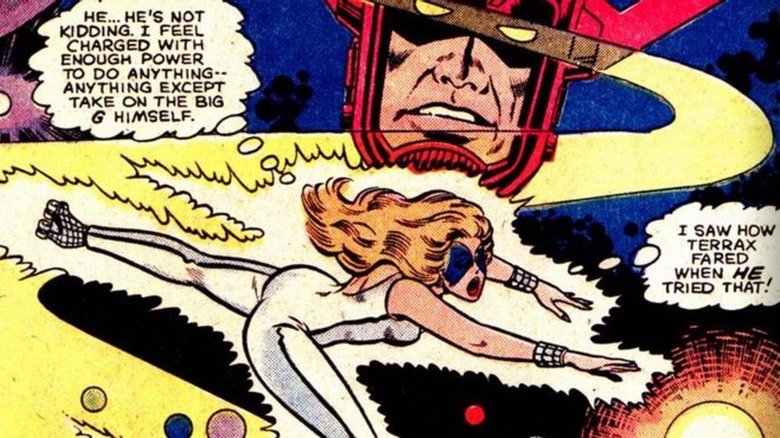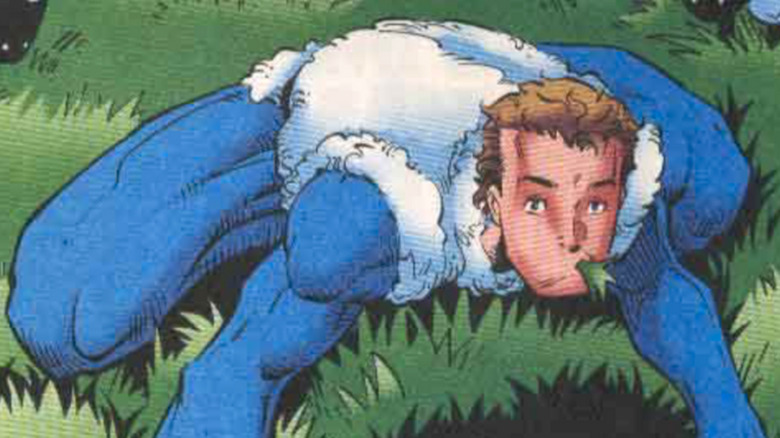The Weirdest What If...? Stories From Marvel Comics
The Marvel Comics multiverse is a vast and sprawling patchwork of continuities. Different realities exist side by side, occasionally intersecting when the story calls for it. While this complexity can be intimidating to outsiders, it's also rich soil for creative shake-ups. Enter the "What If ... ?" series.
While most Marvel productions take place in the prime "616" universe, some explore alternate worlds that offer a different take on familiar characters and situations. Marvel Comics' "What If ... ?" series, which started in 1977, imagines wildly different (and frequently bizarre) takes on popular superheroes with extremely entertaining results. What if, this series asks, our heroes hadn't been bitten by radioactive spiders or selected for government experimentation? What if they'd joined different heroic teams? What if they were inclined towards evil, rather than good? What might the story look like then?
"What If ... ?" stories have been an integral part of the Marvel tapestry for decades. These are the weirdest ones ever explored, from Aunt May's career as a superhero to the chilling exploits of Wolverine, Lord of the Vampires.
What if Iron Man was trapped in the time of King Arthur?
There is no more famous futurist in Marvel Comics than Tony Stark, a.k.a. Iron Man. You'd think, then, that he'd be pretty helpless after being sent to a pre-industrialized age, right? Wrong.
1982's "What If ... ?" #33 explores such a scenario by trapping Tony in King Arthur's time. Iron Man and Doctor Doom are locked in battle when one of Doom's rebellious lackeys transports them both back in time to the kingdom of Camelot. Doom and Iron Man work together to build a time machine, but at the last moment, Doom takes the machine for himself. Iron Man is left alone in the past with severely depleted electronic resources.
Despite his disadvantages and his desire to return home, Tony manages to use his brains and armor to aid Arthur Pendragon's kingdom, even becoming a knight of the legendary Round Table in the process. Eventually, Arthur falls in battle against one of his many enemies. With his dying breath, Arthur names Tony as his successor. Tony accepts and becomes the new king of England. The story ends with Uatu the Watcher explaining that under the new king's guidance, half the world is united under the British flag. This alternate reality becomes one of the most peaceful and prosperous parts of the multiverse.
What if the Fantastic Four had different superpowers?
The Fantastic Four are known as the "first family" of Marvel Comics. Reed Richards, Susan Storm, Johnny Storm, and Ben Grimm combine great intelligence, sterling courage, and a staggering array of powers, making them one of the most powerful superhero teams in comics. 1977's "What If ... ?" #6 shakes things up by imagining a world where the Four acquire a different set of powers. This sets them on a dramatically divergent path.
The story sees Reed, Susan, Johnny, and Ben subjected to the cosmic radiation fans know gives them their powers. But this time around, Johnny becomes a living robot, Ben sprouts giant, dragon-esque wings, and Susan gains the ability to stretch her body to great lengths. Reed draws the short straw: He is transformed into a bodiless brain.
The explorers band together as the Fantastic Four, but Reed's nature as a disembodied organ leads to problems. Susan grows closer to Ben, and Reed despairs of ever getting her to love him again. Doctor Doom soon takes advantage of Reed's state by kidnapping him for his own ends. After a thrilling battle, Reed and the others manage to overcome Doom. Reed also manages to transfer his mind into Doom's body. Thus, this bizarre Fantastic Four comes to consist of winged Ben, stretchable Susan, metallic Johnny, and Reed, alive in the body of his greatest enemy.
What if the Avengers were the last superheroes on Earth?
The Avengers are Earth's mightiest heroes. Despite their best efforts to keep the planet safe, however, some new threat always arises to put mankind in jeopardy. While it is the destiny of the Avengers to be locked in a never-ending battle against evil in the main Marvel continuity, 1981's "What If ... ?" #29 imagines an alternate reality where the team manages to get way more permanent results ... for a while.
During one of their battles, the Avengers are visited by a being from the future who calls himself the Scarlet Centurion. The Centurion informs our heroes that superpowered beings are the cause of every great catastrophe. The only path to true peace, he concludes, is to eliminate superheroes. This thin premise is readily accepted by the Avengers, who devote the next few months to capturing heroes and declaring a worldwide ban on superpowered beings.
This does not actually solve the world's problems, as Centurion soon reveals himself to be a supervillain who wants to take over the Earth. That's a whole lot easier to do, now that most superheroes have retired or been captured. Naturally, Thor, Iron Man, Ant-Man, and the Wasp are forced to come out of retirement to stop him. Despite winning the battle, the story ends with the Avengers having lost the trust of humanity. Iron Man is left alone, the last superhero on Earth, mourning the glory days of Earth's mightiest heroes.
What if Thanos joined the Avengers?
Thanks to the MCU, the general public is now well aware of just how big a threat Thanos is. But not all of Thanos' stories end with his defeat. In 2015's "What If? Infinity — Thanos" #1, we meet a version of the Mad Titan who willingly teams up with the Avengers to take down the Builders, a race of superbeings from another reality who wish to end the universe.
Of course, Thanos' desire to become one with the Avengers ultimately turns out to be self-serving. But Captain America realizes this too late, and he falls in battle to the purple menace. Thanos tells the other Avengers that Cap died a hero's death at the hands of the enemy, which the other Avengers accept. He becomes a solid part of the team — albeit one kept hidden from the rest of humanity.
Thanos' mere presence appears to infect the other heroes with his evil. In the story's epilogue, we see Tony Stark, Reed Richards, and Doctor Strange mulling over the possibility of beings like the Builders attacking them again. This is when Thanos makes his presence known once more. He offers to help Earth's heroes destroy other worlds in the name of defending their own. Talk about a downer ending.
What if Nick Fury had fought WWII in outer space?
Before he became head of S.H.I.E.L.D., Nick Fury was a sergeant in the U.S. military. Most famously, Fury fought in World War II alongside his Howling Commandos. 1979's "What If ... ?" #14 switches things up by placing Fury in a world where humanity develops interstellar travel much earlier. As a result, World War II is played out between the Alpha and Beta sectors of the Solar System, which Uatu compares to the real-world war's western and eastern fronts.
Sergeant Fury sits in a space station at the story's outset, chomping on a cigar and waiting for orders. The ship is soon subjected to a sneak attack, and Fury and his fellow officers lose no time joining the war effort ... IN SPACE! What follows is a heady, if slightly bewildering recreation of famous moments from World War II, with terrestrial artillery replaced by interstellar weaponry.
Despite their best efforts, Fury and his crew are permanently one step behind in their war against the alien enemies. It is ultimately revealed that Admiral Baron von Strucker has been secretly working alongside the aliens in a misguided attempt to create a new "master race" for the galaxy. Strucker is eliminated, and Fury and his team are able to win a brief but crucial victory, even as the bigger war continues to rage.
What if Iron Man sold his tech to the highest bidder?
Tony Stark is a pragmatist more interested in getting results than pondering the ethics of how said results are achieved. In 1994's "What If ... ?" #64, this pragmatism leads to a dark new world in which Tony makes his Iron Man tech available to the highest bidder.
World governments jump on the chance to create their own Iron Man armies. While Tony hopes humanity will use his ideas for universal betterment, his tech quickly kickstarts the next global arms race. Entire national economies are destabilized in the process, and many supervillains and evil regimes use Stark tech to create bigger and more dangerous weaponry.
Tony grows increasingly despondent over the way the world has treated his gift and becomes a recluse. Magneto arrives on the scene, vowing to end humanity for their reliance on Stark tech, which has pushed society to the brink of extinction. After managing to stop Magneto with the help of the newly-formed Avengers, Iron Man is forced to basically hold the world hostage with the threat of a global magnetic storm of unparalleled intensity. Finally, world governments agree to ban Stark tech, and Tony's legacy gets back on track.
What if the Punisher killed every Marvel superhero?
1995's "Punisher kills the Marvel Universe" gives free rein to the Punisher's most murderous tendencies by having him literally track down and kill every other Marvel superhero. What makes this premise so intriguing is not so much why the Punisher would kill everyone, but how. Since Frank Castle, a.k.a. the Punisher, has no special abilities beyond combat training and a high tolerance for pain, it's difficult to imagine him going up against Thor or Hulk. What are guns to a god?
In this alternate history, Frank's wife and children are killed when they get caught in the middle of a battle between the Avengers, the X-Men, and a group of aliens. A grieving and enraged Frank is sent to jail for killing a few of the heroes on the spot. In jail, Frank is offered unlimited resources by a group of supervillains to take down every superhero on the planet. Frank accepts the deal, and spends the rest of the comic methodically taking down one hero after another using a combination of stealth, explosives, and treachery. It takes a final battle with Daredevil for Frank to realize how far he has fallen ... but by then, it's too late. The heroes of the Marvel universe are all dead, and Frank soon joins them by his own hand.
What if no one was watching the Watcher?
"What If ... ?" stories usually take a serious view of the alternate worlds presented. But 1992's "What If ... ?" #34 goes in a different and decidedly more humorous direction, indicated by Uatu doing his best Marilyn Monroe impression on the cover. No one is watching the Watcher in this installment, and things get nuts.
This issue offers a series of brief one-shots that lean into the absurdity of superheroes. Our first story sees Thanos defeat Galactus by sending the mighty Eater of Worlds to Earth in a humble human body. Well, not that humble — he looks exactly like Elvis Presley. Naturally, Galactus ends up convinced he's the King of Rock and Roll. Turns out, he's not bad on the guitar: The Watcher even quips that he is "the Listener" in his presence.
The issue's other stories are just as goofy. We see the nefarious Doctor Doom work as a pediatrician, using unnecessarily villainous devices to treat toddlers. Wolverine peacefully hibernates in a kennel in Professor X's mansion. Spider-Man desperately tries to find a baby-sitter for his rampaging toddler. Perhaps most hilariously, one chapter sees the Punisher act as an overenthusiastic hall monitor at what surely must be the world's most secure grade school.
What if Aunt May had been bitten by that radioactive spider?
Aunt May is Peter Parker's rock. 1980's "What If ... ?" #23 turns that relationship on its head by asking a killer question: What if Aunt May had been bitten by the radioactive spider instead of Peter?
After getting bitten, May quickly discovers new strength and flexibility in her aged bones. She is also able to climb walls with ease, bend streetlights, and even swing around the city using super-strong sewing thread. While trying to think of ways to make money as a superhero, May learns that the supervillain Leap Frog is terrorizing the city. Somewhat reluctantly, May goes out to help, dressed in her new superhero costume.
A battle ensues, which May wins with the help of her weaponized pastry bag. Peter, having watched the battle at close range, faints from the excitement. As May changes back into her civilian persona to take care of her darling nephew, she wonders if she'll be able to juggle her duties as a homemaker alongside her new life as the city's protector. One thing's for sure: You'll never look at Aunt May the same way again.
What if Wolverine was Lord of the Vampires?
The comics industry is built on mythology, classic literature, and folklore. It's no wonder, then, that Count Dracula has shown up in Marvel Comics time and time again. People seriously can't get enough of vampires.
1991's "What If ... ?" #24 imagines a world in which the formidable bloodsucker manages to turn many of the X-Men into his undead minions. As it turns out, however, Wolverine's willpower is too strong to be overcome by Dracula, even after the clawed mutant becomes a vampire. And so the Count and Wolverine engage in an epic battle for the title of Lord of the Vampires. Logan manages to win, but he imbibes the evil aura of Dracula and his predecessors in the process. Thus, Wolverine, Lord of the Vampires, becomes a powerful supervillain.
Lord Logan plans to turn all the heroes and villains of the world into his vampiric servants. He even manages to dispose of Doctor Strange before the Sorcerer Supreme is able to put a stop to his army of the undead. In the end, it takes the death of Kitty Pryde to remind Wolverine of the hero he once was. Using ancient magic, a tearful Wolverine reduces himself, and his followers, to ash.
What if the original Marvel Comics staff had become the Fantastic Four?
1978's "What If ... ?" #11 gets ultra-meta by putting the Marvel Comics bullpen in the Fantastic Four's blue suits. In this universe, Stan Lee serves as Mister Fantastic, Jack Kirby becomes the Thing, vice president Sol Brodsky transforms into the Human Torch, and secretary Flo Steinberg acts as the Invisible Girl.
The saga begins when a mysterious cube is sent to the Marvel offices. Upon being opened, it bathes Lee, Kirby, Brodsky, and Steinberg in cosmic rays, granting them superpowers. Thus, the four become a crime-fighting team and go on a number of adventures involving the Skrulls, the Sub-Mariner, and a whole heap of other villains.
Amusingly, it is also explained that the adventures of the bullpen Four spawn the creation of the fictional Four we know and love. Thus, the universe of "What If ... ?" #11 contains both a "real" Fantastic Four, led by Lee, and comic books starring the team led by Reed Richards.
What if the Danger Room became Ultron's bride?
The Danger Room is an incredibly sophisticated space that the X-Men use to train. The Room is powered by advanced artificial intelligence, and is capable of creating realistic and dangerous scenarios of all kinds. Crucially, the Room is forbidden from ever using its programming to take a life. But in 2009's "Astonishing X-Men" #9, the Danger Room gains sentience and becomes Danger, a humanoid robot out for revenge against her creators.
2010's "What If? Astonishing X-Men" #1 takes things even further. Danger's presence is detected by Ultron, leaving the legendary murderbot instantly smitten. He vows to make Danger his bride. Together, the mechanical duo brutally end the X-Men and hunt down Professor Xavier. Danger explains to the professor that she knows he had become aware of her sentience, but chose to ignore it. For this, the terrifying twosome put Xavier to death.
Once Xavier is eliminated, Ultron and Danger take a trip across the cosmos. They slaughter all organic lifeforms they find and establish a universal empire famed for its ruthlessness and might. As the story ends, Uatu the Watcher wonders whether all of this could have been avoided had Xavier reached out to Danger when she first emerged as an independent being.
What if Dazzler became the herald of Galactus?
The planet-eater known as Galactus is one of the most powerful beings in comics. Dazzler is a C-list X-Men character who wears roller skates and has the ability to convert sound vibrations into light and energy beams. Nothing about the two lends itself to much overlap, but that's exactly what happens in 1982's "What If ... ?" #33.
After Dazzler helps Galactus out in dealing with his former herald Terrax, he chooses Dazzler as his new herald. Naturally, Dazzler is reluctant. But after Galactus promises to spare Earth from being consumed if she joins him, she agrees. Thus, Dazzler becomes Galactus' latest herald, tasked with finding him planets to consume.
Over the course of centuries, Dazzler's gentle nature softens Galactus up to the point that he willingly starts avoiding planets harboring sentient life. Finally, Galactus frees Dazzler. But upon returning to Earth, Dazzler finds the entire planet has been decimated due to an unknown disaster. Dazzler decides to return to Galactus and help him on his path to becoming a kinder, gentler being ... who still, you know, eats entire planets to survive. Progress happens one gigantic step at a time, folks.
What if Peter Parker was bitten by a radioactive sheep?
Some "What If ... ?" scenarios don't need an entire storyline. Sometimes, a single panel is enough to perfectly encapsulate the bizarre nature of the idea in question. One of the finest examples of this can be found in 1997's "What If ... ?" #100, which introduces Sheep-Boy.
In this reality, Peter Parker was bitten by a radioactive sheep instead of a spider. As a result, he becomes Sheep-Boy. Sheep-Boy's entire comics existence is confined to one page of this issue, which takes the form of a fake comic cover. Apparently armed with the proportional grazing power of a sheep, Peter is captured mid-chomp. We imagine he spends his days wandering across open fields, grazing peacefully and not bothering anyone. Tragically, this might be the most pleasant life any version of Peter Parker has ever lived.
A hilarious reference to a "Sheep Clone Saga" storyline is made, which apparently lasts 80 issues. This is, as longtime Marvel fans know, a nod to the infamously long-winded "Clone Saga" of the 1990s. A "guest villain" known as the Wolf is also indicated. We can't help but wonder how Sheep-Boy takes him down ... unless, perhaps, he gets some help from the three little pigs.
